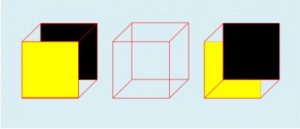The Necker shift is named after a visual illusion called the Necker cube.
The image below shows a classic Necker cube in the centre, with a different interpretation on each side of it.
The cube in the centre can be interpreted in two ways.
In the interpretation on the left, the yellow face is at the front.
In the interpretation on the right, the yellow face is at the back, and the front face is black.

The traditional Necker cube is a purely visual effect. However, this deep structure also applies to a broad range of situations, beyond visual effects.
Often, there are two ways of making sense of a situation, but only one of them is correct. This can lead to serious misunderstandings, because each interpretation is sensible, and people may not spot that there’s a different possible interpretation from the one that they have seen. This is different from vagueness, where the situation is obviously unclear.
When people spot the alternative interpretation, they suddenly re-perceive the situation in a completely different way. This often takes the form of an unwelcome shock, but can also be an enlightening insight.
This is closely related to the concept of the uncanny valley, where an object or situation makes people feel uncomfortable because it falls between two categories (e.g. dolls or robots that look almost, but not quite, human).
We’ve written about Necker shifts in more detail on the Hyde and Rugg blog in relation to;